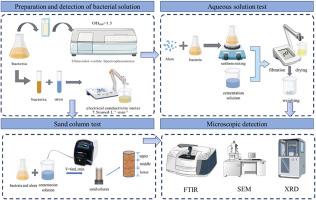Alum-Enhanced MICP for Sand Stabilization: Mechanisms and optimization
IF 5.8
2区 化学
Q2 CHEMISTRY, MULTIDISCIPLINARY
引用次数: 0
Abstract
Microbial-induced calcium carbonate precipitation (MICP) is an environmentally friendly novel ground improvement technology. This study proposes an innovative alum-enhanced MICP technique to address critical challenges in traditional MICP applications for sand reinforcement, including prolonged construction duration, low treatment efficiency, and poor uniformity. Through systematic aqueous solution tests and sand column experiments, this study investigated the pH regulation mechanism of alum in MICP processes and its dual effects on calcium carbonate precipitation patterns and hydration product formation. Advanced characterization techniques including scanning electron microscope, X-ray diffraction, and fourier transform infrared spectroscopy were employed to elucidate the microstructural evolution. The results show that the addition of appropriate alum (3 mmol/L) significantly enhances the MICP effect through three synergistic mechanisms: (1) alum induced a shift in calcium carbonate crystallization from vaterite to calcite, resulting in a 180 % increase in calcite content. (2) analysis of variance results showed that alum addition significantly improved the spatial distribution uniformity of the precipitate, and (3) hydrocalumite, aluminum hydroxide, and calcium carbonate formed a framework cementation structure, which significantly improved the degree of cementation and strength of the specimens. Under these mechanisms, the addition of 3 mmol/L alum enabled the sand column to achieve stabilization after a single treatment cycle, reducing treatment time and cementation solution usage by over 70 % compared to conventional MICP. After five treatment cycles, the sand's strength showed an 851 % increase compared to the control group. The demonstrated techno-economic advantages highlight the potential of alum-enhanced MICP as a sustainable solution for sand ground improvement.

用于防砂的铝增强MICP:机理与优化
微生物诱导碳酸钙沉淀(microinduced calcium carbonate precipitation, MICP)是一种环保的新型土地改良技术。本研究提出了一种创新的铝增强MICP技术,以解决传统MICP加固砂的关键挑战,包括施工时间长、处理效率低和均匀性差。本研究通过系统的水溶液试验和砂柱实验,探讨了明矾在MICP工艺中的pH调节机制及其对碳酸钙沉淀模式和水化产物形成的双重影响。利用扫描电子显微镜、x射线衍射和傅里叶变换红外光谱等先进表征技术来阐明微观结构的演变。结果表明,适量添加明矾(3 mmol/L)可通过3种协同机制显著增强MICP效应:(1)明矾诱导碳酸钙结晶由水晶石向方解石转变,使方解石含量提高180%;(2)方差分析结果表明,明矾的加入显著改善了析出物的空间分布均匀性;(3)水矾土、氢氧化铝和碳酸钙形成框架胶结结构,显著提高了试样的胶结程度和强度。在这些机制下,加入3mmol /L明矾可以使砂柱在单次处理周期后实现稳定,与常规MICP相比,减少了处理时间和固井液用量70%以上。经过5个处理周期后,沙子的强度比对照组增加了851%。所展示的技术经济优势凸显了铝增强MICP作为砂土改善可持续解决方案的潜力。
本文章由计算机程序翻译,如有差异,请以英文原文为准。
求助全文
约1分钟内获得全文
求助全文
来源期刊

Sustainable Chemistry and Pharmacy
Environmental Science-Pollution
CiteScore
8.20
自引率
6.70%
发文量
274
审稿时长
37 days
期刊介绍:
Sustainable Chemistry and Pharmacy publishes research that is related to chemistry, pharmacy and sustainability science in a forward oriented manner. It provides a unique forum for the publication of innovative research on the intersection and overlap of chemistry and pharmacy on the one hand and sustainability on the other hand. This includes contributions related to increasing sustainability of chemistry and pharmaceutical science and industries itself as well as their products in relation to the contribution of these to sustainability itself. As an interdisciplinary and transdisciplinary journal it addresses all sustainability related issues along the life cycle of chemical and pharmaceutical products form resource related topics until the end of life of products. This includes not only natural science based approaches and issues but also from humanities, social science and economics as far as they are dealing with sustainability related to chemistry and pharmacy. Sustainable Chemistry and Pharmacy aims at bridging between disciplines as well as developing and developed countries.
 求助内容:
求助内容: 应助结果提醒方式:
应助结果提醒方式:


